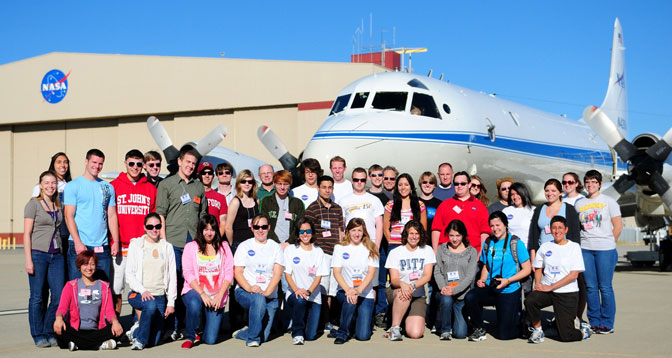 More than 30 undergraduate and graduate students from a like number of colleges and universities gathered in front of NASA’s P-3B Orion Earth science aircraft at the Dryden Aircraft Operations Facility in Palmdale, Calif., prior to a research mission June 25. The students are participating in the fourthannual NASA Student Airborne Research Program, a summertime immersion in NASA’s Earth science research. › View Larger Image
More than 30 undergraduate and graduate students from a like number of colleges and universities gathered in front of NASA’s P-3B Orion Earth science aircraft at the Dryden Aircraft Operations Facility in Palmdale, Calif., prior to a research mission June 25. The students are participating in the fourthannual NASA Student Airborne Research Program, a summertime immersion in NASA’s Earth science research. › View Larger Image
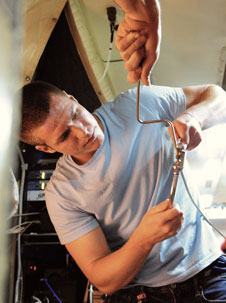 SARP participant Peter Kelly, a senior at the U.S. Coast Guard Academy, bends tubing in preparation for the installation of the Whole Air Sampler instrument onboard the P-3B.
SARP participant Peter Kelly, a senior at the U.S. Coast Guard Academy, bends tubing in preparation for the installation of the Whole Air Sampler instrument onboard the P-3B.
› View Larger Image
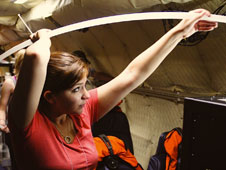 SARP participant Alexandra Limon, a senior chemistry major from Columbia University in New York, assists in the installation of air quality instruments from the University of Houston on board NASA’s P-3B.
SARP participant Alexandra Limon, a senior chemistry major from Columbia University in New York, assists in the installation of air quality instruments from the University of Houston on board NASA’s P-3B.
› View Larger Image
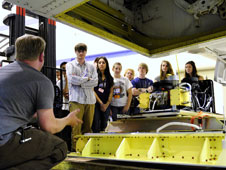 James Jacobson of NASA Ames Research Center and the University of California at Santa Cruz describes the MASTER remote sensing instrument to SARP student participants as it is installed in NASA’s P-3B.
James Jacobson of NASA Ames Research Center and the University of California at Santa Cruz describes the MASTER remote sensing instrument to SARP student participants as it is installed in NASA’s P-3B.
› View Larger Image
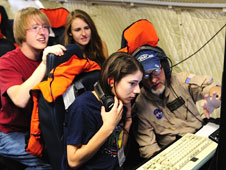 Students watch intently as Dennis Gearhart from NASA Ames and UC-Santa Cruz details data from the MASTER remote sensing instrument on NASA’s P-3B Earth sciences aircraft is displayed on a monitor in front of them during aresearch flight. Emma Accorsi, a senior from Emory University (front center), James Allen from the University of Tennessee and Samantha Trumbo from Cornell University are participants in NASA’s 2012 Student Airborne Research Program.
Students watch intently as Dennis Gearhart from NASA Ames and UC-Santa Cruz details data from the MASTER remote sensing instrument on NASA’s P-3B Earth sciences aircraft is displayed on a monitor in front of them during aresearch flight. Emma Accorsi, a senior from Emory University (front center), James Allen from the University of Tennessee and Samantha Trumbo from Cornell University are participants in NASA’s 2012 Student Airborne Research Program.
› View Larger Image PALMDALE, Calif. – Thirty-two undergraduate and graduate students are participating in a NASA Airborne Science Program field experience at NASA’s Dryden Aircraft Operations Facility in Palmdale, Calif. this week designed to immerse them in the agency’s Earth science research. The students represent 30 different colleges and universities from across the United States. They were selected based on outstanding academic performance, future career plans and interest in the Earth System sciences.
NASA’s Student Airborne Research Program (SARP), now in its fourth year, provides a unique opportunity for undergraduate and graduate students majoring in the sciences, mathematics and engineering to participate in all aspects of a NASA Airborne Science research campaign. Flying on NASA’s P-3B Orion airborne laboratory, students are measuring airborne pollution in the Los Angeles basin and in California’s Central Valley, water use in agricultural crops in the San Joaquin Valley, and ocean biology along the California coast. In addition to airborne data collection, students are taking measurements at field sites.
SARP participants are given a rare behind-the-scenes look at instrument installation, flight planning and payload testing that is the basis of every successful NASA Earth science airborne campaign. These campaigns play a pivotal role in the calibration and validation of NASA’s space-borne Earth observations, remote sensing measurements and high-resolution imagery for Earth system science.
The eight-week 2012 SARP began June 18 at NASA Dryden’s Palmdale facility with lectures by university faculty members, NASA scientists and program managers. To facilitate the California-based SARP flights, the NASA P-3B Orion flew from its home base at the Wallops Flight Facility in Wallops Island, Va., to the Palmdale facility adjacent to U.S. Air Force Plant 42. The students are collecting data during six flights of the P-3B over southern and central California during the week of June 25. They are acquiring imagery of kelp beds in the Santa Barbara Channel and vineyards near Delano, Calif. In addition, the several missions will overfly dairies in the San Joaquin Valley and parts of the Los Angeles basin at altitudes as low as 1,000 feet to collect air samples and monitor air quality.
The final six weeks of the program will take place at the University of California, Irvine, where students will analyze and interpret the data they collected aboard the aircraft and deliver a final presentation on their results and conclusions.
The Student Airborne Research Program is one of NASA’s tools for training future scientists for Earth Science missions that support environmental studies and the testing and development of new instruments and future satellite mission concepts. The program’s goal is to stimulate interest in NASA’s Earth Science research and aid in the recruitment of the next generation of scientists and engineers.
NASA’s Dryden Aircraft Operations Facility is the Dryden Flight Research Center’s base of operations for its airborne science aircraft. SARP is managed through the National Suborbital Education and Research Center at the University of North Dakota, with funding and support from NASA’s Airborne Science Program.
For more information about the Airborne Science Program, visit:
http://airbornescience.nasa.gov
For additional information about NASA’s P-3B, visit:
http://airbornescience.nasa.gov/aircraft/P-3_Orion
For additional information about SARP, visit:
http://www.nserc.und.edu/learning/SARP2012.html
Photo Credit: NSERC/Jane Peterson
– end –
text-only version of this release
To receive status reports and news releases issued from the Dryden Newsroom electronically, send a blank e-mail message to dfrc-subscribe@newsletters.nasa.gov. To unsubscribe, send a blank e-mail message to dfrc-unsubscribe@newsletters.nasa.gov. The system will confirm your request via e-mail.
Leslie Williams
Dryden Flight Research Center
661-276-3893
leslie.a.williams@nasa.gov
Emily Schaller
National Suborbital Education and Research Center
701-317-0789
e.schaller@nserc.und.edu


























